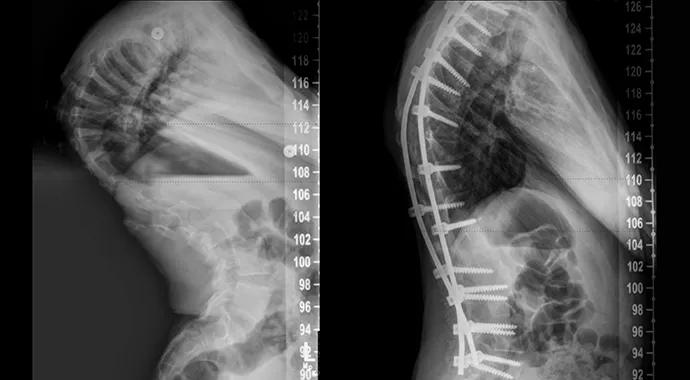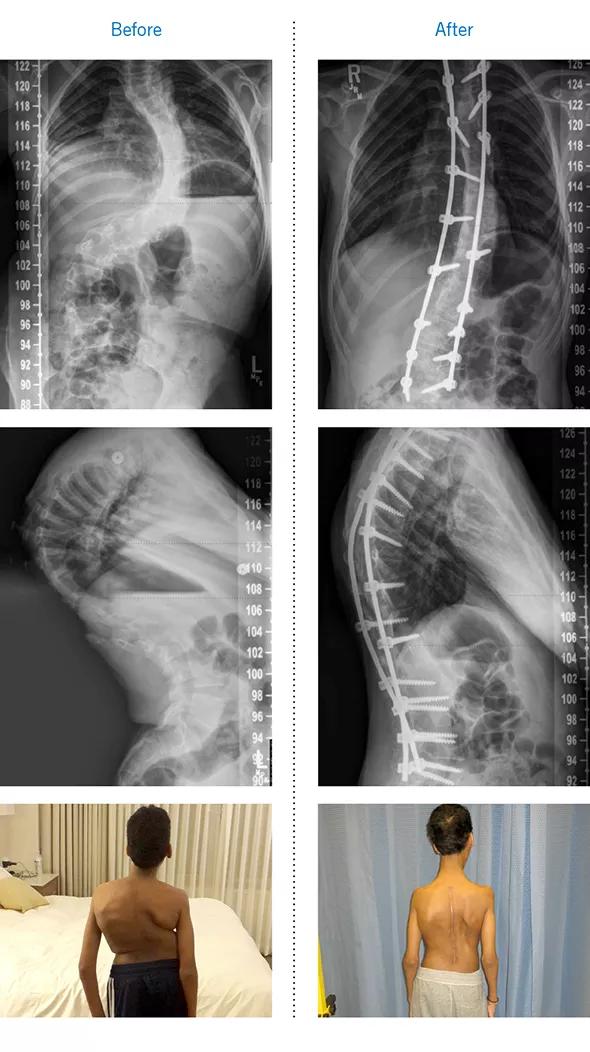Advertisement
Complementary therapies trim length of stay by a month

By David Gurd, MD; Benjamin Katholi, MD; and Chelsea Behling, PT
Advertisement
Cleveland Clinic is a non-profit academic medical center. Advertising on our site helps support our mission. We do not endorse non-Cleveland Clinic products or services. Policy
A 16-year-old male international patient presented to Cleveland Clinic Children’s Center for Pediatric Orthopaedics and Spine Deformity with significant, rapidly progressing kyphoscoliosis.
Radiographs revealed a 90-degree thoracic curve, a 67-degree lumbar curve and 100-degree kyphosis. After assessment by neurology, genetics, orthopaedics, pulmonary medicine and cardiology, the patient was found to have multiple medical problems and severely compromised pulmonary function. His condition was consistent with the kyphoscoliotic form of Ehlers-Danlos syndrome.
Spinal fusion was recommended. It was felt that the risk of neurological damage could be reduced by elongating the spine before surgery. After a lengthy discussion with the patient and family about risks, benefits and possible complications, the decision was made to proceed with treatment.
Several weeks after his presentation, the patient was taken to surgery at Cleveland Clinic’s main campus and fitted with a halo brace. He was then transferred to Cleveland Clinic Children’s Hospital for Rehabilitation to begin intensive “prehabilitation.”
At Cleveland Clinic Children’s, orthopaedic surgeons typically employ halo traction for three months prior to scoliosis surgery in severe scoliosis cases, particularly with kyphosis, where the deformity is significant. Use of gradual traction allows for safe stretching of soft tissues, including major blood vessels, the esophagus and nerves. Gaining elongation in the stiff, large curves makes definitive fusion safer and easier. Halo traction is not typically used for standard curves.
Advertisement
Beds, chairs, walkers and wheelchairs equipped with pulley systems enable patients to remain in traction 23 hours a day. For this patient, traction was initiated at 10 lbs. in the chair and walker and 5 lbs. in bed.
The patient’s initial therapy focused on spinal stretching and muscle strengthening. Traction was increased by 2 lbs. per day up to 40 lbs. in the chair and walker and 10 lbs. in bed.
As the patient’s body adapted, he began to experience pain in his back and sides. The physical therapists noted areas of fascial thickening and initiated a program of myofascial release using deep dural pulls. The patient’s pain rapidly decreased, and his alignment rapidly improved. The therapists were granted permission to keep the patient off traction for longer periods to work on his fascia and provide postural retraining.
After only two months of intensive therapy, the patient underwent successful posterior spinal fusion from T2 to L4. The next day, he resumed myofascial release therapy, gait training, stretching and taping, and yoga. In 10 days, he was discharged to rehabilitation at the day hospital, with biofeedback for postural retraining added to his therapeutic regimen. After 12 days, he was discharged to outpatient physical and occupational therapy.
When the patient was last seen, he had a 32-degree thoracic curve, a 27-degree lumbar curve and 51-degree kyphosis. His pulmonary function had increased by 33 percent from his initial presentation approximately six months earlier. He was ambulating with a nonantalgic gait and had gained several inches in height. His parents felt he was dramatically better not just physically (see photos below) but also psychologically and socially.
Advertisement

Radiographs and photographs of the case patient at presentation (left) and after spinal fusion and rehabilitation (right).
Cleveland Clinic Children’s Hospital for Rehabilitation is accustomed to patients with complex care needs. Such patients can also receive multidisciplinary assessment by a team at the Center for Pediatric Integrative Medicine with individual expertise in complementary therapies. The goal is to identify impairments that may play a role in aggravating symptoms and to incorporate specific services into the child’s care plan to improve global functioning.
For this patient, myofascial release complemented the innovative use of traction to counteract the extreme kyphosis and to lengthen nerve fibers gradually. Breaking down the thickened fascia that would have complicated spine-straightening efforts lessened the patient’s pain and shortened his length of stay by one month.
Other complementary therapies incorporated into this patient’s rehabilitation plan included:
We have found that prehabilitation prior to spinal fusion results in fewer postsurgical complications. While this young man has other medical problems that will need to be addressed, no additional surgery or therapy for his spinal issues should be required.
Dr. Gurd is a pediatric orthopaedic surgeon in Cleveland Clinic Children’s Center for Pediatric Orthopaedics and Spine Deformity.
Advertisement
Dr. Katholi is a pediatric physiatrist in Cleveland Clinic Children’s Department of Developmental and Rehabilitation Pediatrics and the Center for Pediatric Integrative Medicine.
Ms. Behling is a physical therapist in the Center for Pediatric Integrative Medicine and Cleveland Clinic Children’s Hospital for Rehabilitation.
Advertisement
Advertisement

Conservative treatments were ineffective for 29-year-old with chronic heel pain

For patients with anatomic abnormalities, substantial bone loss and pre-existing hardware

Machine learning models assess intraoperative tissue perfusion

Growth modulation procedures are effective if the condition is diagnosed before the patient reaches skeletal maturity

Research by Cleveland Clinic and Sports Data Labs to improve health and function in everyday patients as well as elite athletes

Cleveland Clinic’s Esports Medicine team weighs in on importance of multidisciplinary care

Patient loses 148 pounds in 18 months, reduces BMI to 26

Sinus tracts can occur years later and not near the incision site